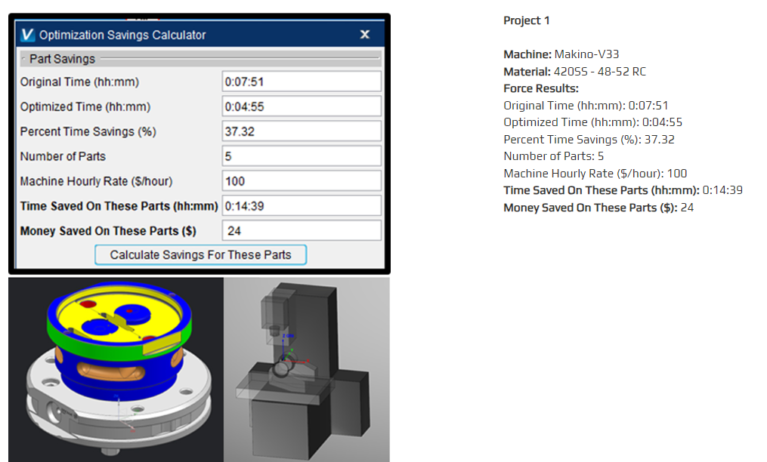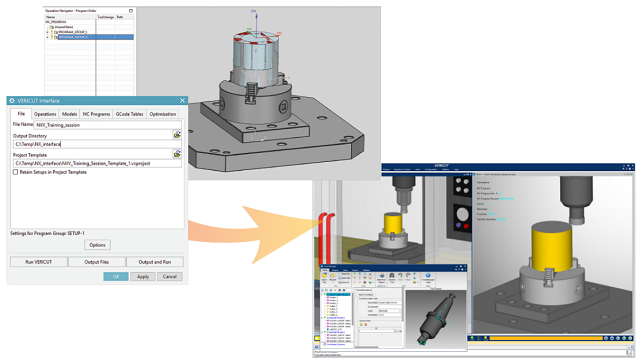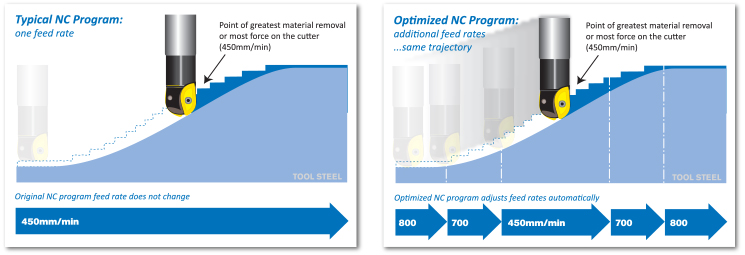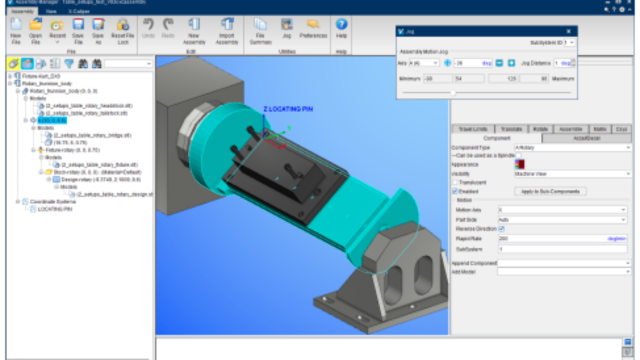VERICUT Force: Optimization of an Automotive Mold – Miju Precision Co., Ltd. MIJU PRECISION Co., Ltd., Located in Hwaseong City in South Korea, was established in 1990. South Korea’s leading injection mold manufacturer produces molds in various fields, such as home appliances and automotive parts. It is also a first-tier vendor for Samsung Electronics.
Despite the recent recession, and downturns in the mold & die industry, MIJU has maintained its good business by winning projects based on its excellent technology, but not without difficulties.
A typical mold part requires long machining hours, and customers are increasingly demanding shorter delivery times. As a result, the sales department, facing repeated delays in delivery due to the conventional processing time, was experiencing difficulties in dealing with customers. Already aware of VERICUT’s Force optimization module and it’s ability to reduce machining time, MIJU reached out to CGTech. With CGTech’s help, MIJU began its first test of the Force module in August of 2023.
Test machining part – Automotive mold
The testing part was a mold steel (HP4M) automotive door trim injection mold with 960 x 980 x 197.19 mm (X*Y*Z) dimensions.
The part is cut with 81 NC programs of 292MB and processed by an OKUMA machine. Of these 81 programs, 13 that corresponded to the roughing process were already completed, so the Force optimization test was done on the 68 NC programs for the semi-finishing and finishing process.
VERICUT Force optimization strategy (Settings)
Chip thickness setting: Feed per tooth (Fz) is determined by the spindle, feed, and number of teeth, representing the maximum chip thickness. To achieve the most productive machining, it is essential to maintain the maximum chip thickness during cutting. The testing parties decided that the Feed per tooth value as it is for the current material, HP4M mold steel, might not be suitable, so the optimization setting was set at 95% of the chip thickness value, which was obtained through the Force analysis. The 95% was selected based on CGTech’s accumulated data and know-how through various past tests done by CGTech.
Cutting force setting
For the roughing and semi-finishing process, the cutting force was set at 95%, and for the finishing process, 90% of the analyzed value.

Maximum feed rate
The maximum feed rate during cutting load-generating paths was set to double the existing feed rate.
Air-cut feed rate
The air-cut feed rate, or the fastest machining speed applied when tool engagement with the material is not occurring, was set to a maximum of 10,000mm/min. The air-cut feed means the maximum feed rate when the tool does not touch the material for G01, G02, and G03 commands.
The above optimization settings make it possible to manufacture a part safely by using an optimal feed rate, while maintaining the consistent maximum chip thickness. The feed rate is automatically decreased to avoid overload, and increased when possible, resulting in shorter machining times.
VERICUT Force analysis comparison
Case 1
First, let’s examine the bar cut analysis results of the rough turning process using the D12 Ball tool during this test machining (Chart 1).
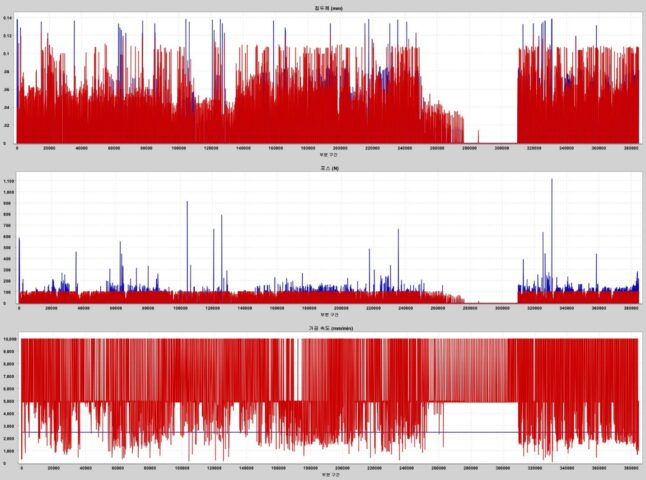
The analysis revealed several overloaded sections with a cutting force of up to 1,200N. Therefore, the cutting force setting was lowered to 95% or 105N, and dramatic overloads were optimized with safer feed. The chip thickness condition was set at 0.138 mm, and the feed, initially set at 2,500 mm/min, was increased to 5,000 mm/min. As a result of these adjustments, the machining time in VERICUT decreased from the previous 6 hours to 3 hours and 40 minutes, representing an approximately 40% reduction.
Let us take a closer look at one of the overloaded sections. (Chart 2) The overload was caused because the tool entry speed was not slow enough as the tool entered the Z direction (a plunge entry section). The Force optimized it with a safer feed rate. The Force chart (Chart 2) shows the spikes in the blue line (before optimization), which were adjusted with Force (in the red line) to avoid overload and cut safely. After optimization, the cutting force was lowered from 1,118 N to 92 N. The feed rate decreased from 2,500mm/min to 100mm/min.
Case 2
The second case to review is the analysis value of a finishing process using a D12 Ball tool.

Since feed rate and surface quality are essential for the finishing process, chip thickness and cutting force were optimized using safer settings, resulting in time-saving and better surface quality. The cutting force setting was set to 99 N, which is 90% of the analysis value, and the chip thickness setting was set to 0.15 mm, but the existing slow feed of 2,000 mm/min was doubled to 4,000 mm/min. As a result, the cutting time was reduced by around 24% from 23 to 18.5 hours.
Force chart providing intuitive judgment
Force charts helps the analysis process to be more reliable and intuitive. The Force graph shows only about 3% of the entire tool path was exceeding cutting force, which supports the decision to apply a 95% cutting force setting for the roughing/semi-finishing processes. Even though the overload section constitutes only 2-3% of the total, maintaining an ineffective feed rate for the sake of safe machining in these areas leads to inefficient settings on-site, resulting in increased machining time. Also, the Force graph shows the ratio of the air-cuts and zero-load sections. In this case, around 30% of the tool path was either air-cuts or zero-load sections.

Time reduced by 35% with Force optimization
The optimization software that MIJU has been using estimates 192 hours of cutting time. MIJU usually expects a 15% increase in the cutting time due to the acceleration/deceleration of the machine tools, so the final cutting time was estimated at 220.8 hours, which is around nine days.
VERICUT Force after simulation estimated 118 hours of cutting time, and the actual cutting time was 144 hours (6 days) with 26 hours of time added from the machine acceleration/deceleration, resulting in a time reduction of 35%. CGTech sales engineer, Il-Chan Cho, said, “As it is a test process, we have not been able to grasp all the data of the MIJU. Despite this, we achieved good results even though the optimization was done without thorough analysis processing.” adding, “Considering that optimizing the roughing process with VERICUT Force tends to show an even more dramatic time reduction, I believe that the overall cutting time including the roughing, which would take 15 days to process, could have been completed within nine days with Force.”
After the successful test, MIJU internally shared the result, and MIJU’s president approved the purchase of one copy of each VERICUT and Force, including the EDM simulation function last November. Joong Jae Lee, the CEO and president of MIJU said, “Through this test, we clearly understand the excellence of VERICUT. However, whether the software implementation was successful or not is determined by how well our staff utilizes the software. CGTech is providing training sessions to familiarize MIJU employees with the software.
CGTech sales engineer, Il-Chan Cho, said, ” With the introduction of the VERICUT Force, MIJU can earn thousands of dollars in increased profits per machine every year.” “MIJU will need a systemized cutting conditions database for RPM, feed rates, etc., to improve productivity with Force. For this, CGTech will continuously support MIJU.”
Sourse: MIJU PRECISION – VERICUT USA (cgtech.com)
Contact us for free and detailed advice


